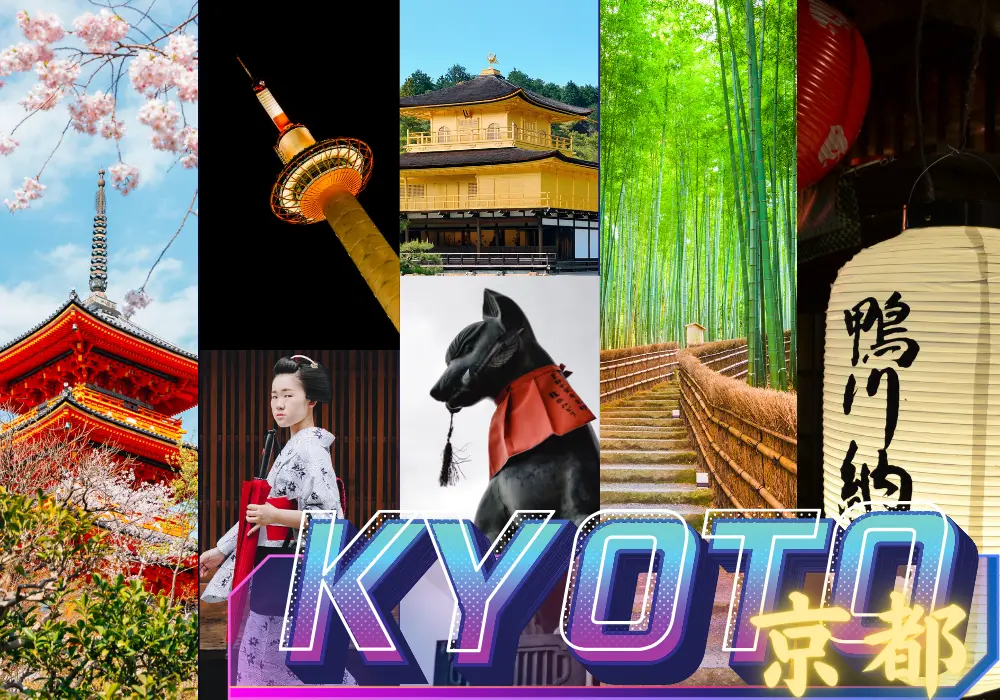Heian Shrine is a historic shrine located in the heart of Kyoto.
Within its expansive grounds, you’ll find beautiful gardens that showcase the natural beauty of each season. For travelers, it’s a place where you’re sure to find plenty of photo-worthy spots.
In this article, we’ll highlight the main attractions of Heian Shrine and provide detailed tips and recommendations for strolling through the Divine Garden. Experience the harmony of history and nature by visiting Heian Shrine.
Heian Jingu Shrine
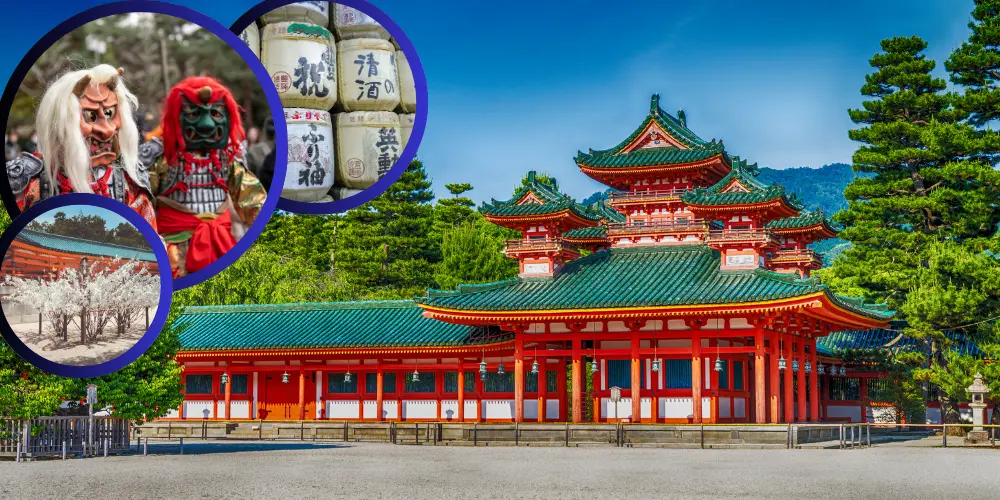
Good experience
One of the famous heian shrine.. Its very calm and quite very large space in the shrine and there is a garden which is good. The larger tori gate was very big and marvellous.. You can feel the calm and composed mind inside the shrine. Very wide road to enter to the shrine give the comfortable parking and easy access. It is the one of the best shrine. Overall good experience
The big impressive shrine
This is one of the big impressive shrines in Kyoto with its signature red torri as well as other buildings painted in bright red too. Nice view from within the shrine towards the mountains. Big wide garden can be visited against a fee and worth it especially in spring and autumn. Good starting point to walk to Gion. Early morning not yet very crowded.
Must-visit classic spot
Heian Shrine is indeed a must-visit classic spot in Kyoto Prefecture, Japan. Be sure to also visit the beautiful Japanese garden located within the grounds of Heian Shrine.
From Google Review – Heian Shrine
| Open Hours | 6:00 – 18:00 |
| Official Website | https://www.heianjingu.or.jp/index.html |
Heian Shrine was established in 1895 (Meiji 28) to commemorate the 1100th anniversary of the capital’s relocation to Heian-kyō.
It enshrines Emperor Kanmu, the 50th emperor of Japan, and was built by the people of Kyoto who wished to restore the city, which had fallen into disrepair during the late Edo period conflicts. The shrine features popular photo spots such as the Shinen garden, which showcases a millennium of Heian-kyō landscaping techniques, the beautiful vermilion Daigokuden (main hall), and the iconic Otorii gate.
The Daigokuden (main hall) is a scaled-down reconstruction of the Chōdō-in, the main administrative building of the imperial palace in Heian-kyō. It preserves the elegant and refined atmosphere of Kyoto during the Heian period. The Daigokuden is designated as an Important Cultural Property of Japan, and it serves as the site for major national ceremonies, such as the emperor’s enthronement and New Year’s celebrations.
Highlight of Heian Shrine
Heian Shrine is located in the heart of Kyoto and boasts many attractions.
In this section, we will explore the highlights and must-visit points of Heian Shrine. With its beautiful gardens, the vibrant vermilion Daigokuden, and the iconic Otorii gate, ready your smartphone camera when you visit those spots. When visiting Kyoto, make sure to experience this historic site.
Heian-Jingu Shrine Grand Torii
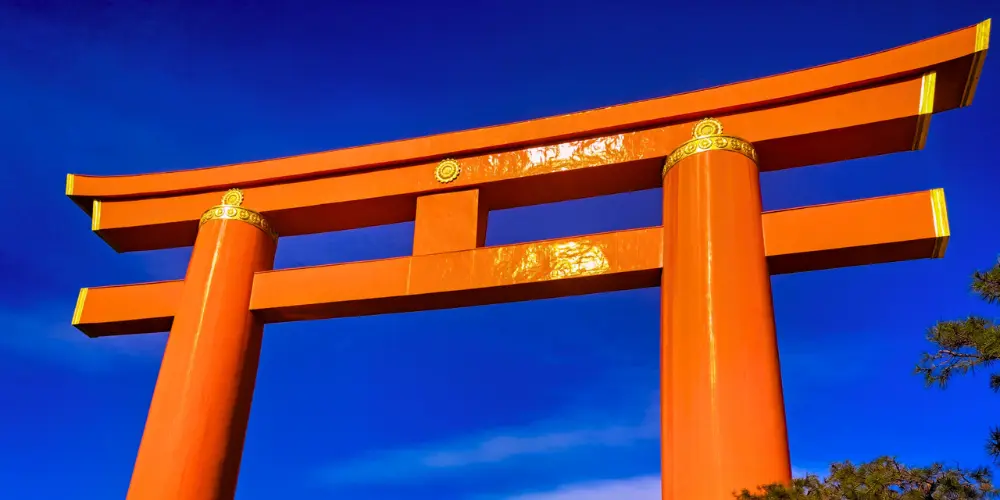
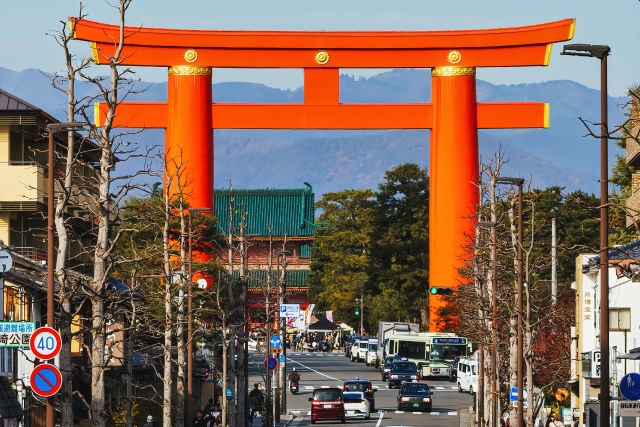
When visiting Heian Shrine, the first thing you should see is the enormous grand torii gate, a symbol of the shrine and a Registered Tangible Cultural Property.
This impressive structure, standing 24 meters tall and 18 meters wide, was built in 1928 to commemorate Emperor Showa’s enthronement.
At the time, it was the largest torii gate in Japan. Today, it remains a popular photo spot for many visitors to Kyoto. Its grandeur and beauty are not only worth capturing in photos but also worth experiencing in person.
Outemmon Gate
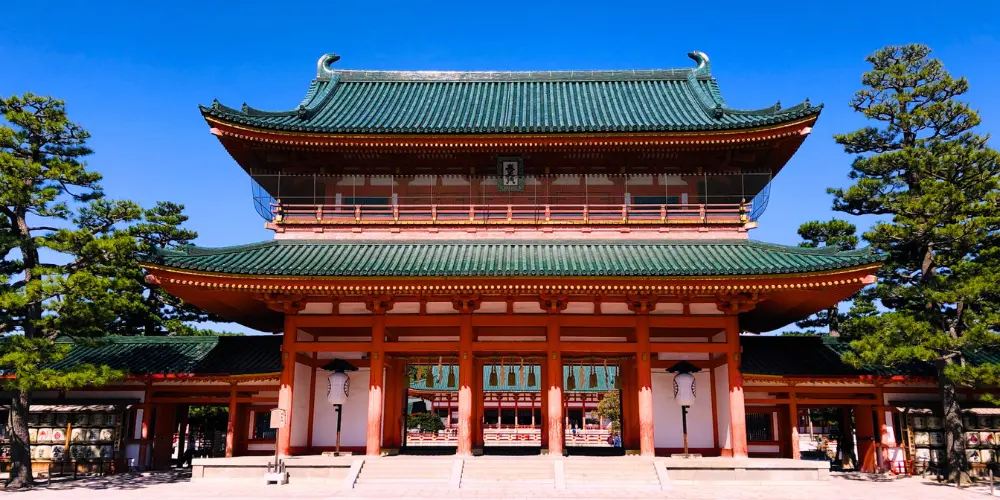
Located straight ahead from the great torii gate is the two-story tower gate, “Otenmon,” modeled after the Otenmon gate of the Chodoin in Heian-kyō.
This gate is beautifully painted in vivid vermilion and is designated as an Important Cultural Property of Japan. Built along with the Daigokuden and other structures during the establishment of Heian Shrine, the Otenmon also served as a monument for the National Industrial Exhibition at the time.
Daigoku-den (Heian Shrine Outer Oratory)
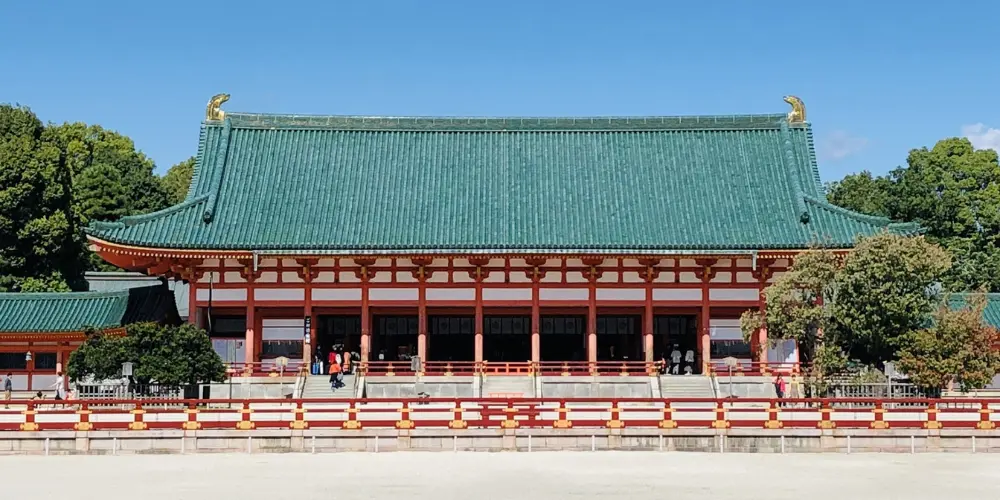
Passing through the Otenmon gate, the entrance of Heian Shrine, you will see the Daigokuden extending to the left and right in front of you.
This grand hall, designated as an Important Cultural Property of Japan, is a 5/8 scale replica of a Heian period government building, with a span of 33.3 meters on either side. The Daigokuden serves as the outer hall of worship at Heian Shrine, where visitors pray towards the main hall.
In ancient times, the Daigokuden was the most important building of government, where the emperor conducted state affairs and held significant ceremonies such as imperial audiences and enthronements. It was constructed in the 28th year of the Meiji era as part of the 1100th anniversary project commemorating the capital’s relocation to Heian-kyō, modeled after Heian period architecture.
The Daigokuden at Heian Shrine is a unique cultural heritage site that allows visitors to reminisce about the grandeur of the Heian period.
Souryuro Tower and Byakkoro Tower
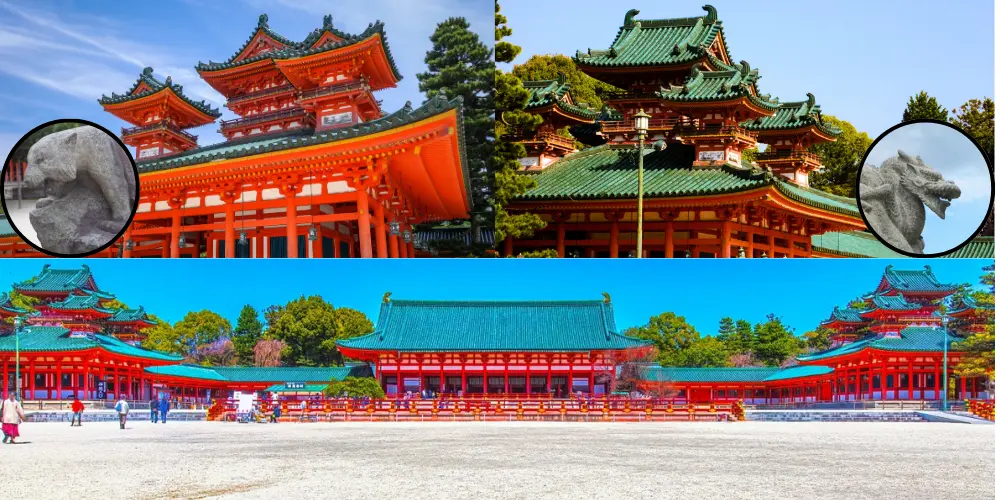
The Soryu-ro and Byakko-ro Towers of Heian Shrine were constructed in 1895 (Meiji 28). These towers are modeled after the four towers of the Chodo-in, with Soryu-ro located southeast of the Daigokuden and Byakko-ro located southwest of the Daigokuden.
It is said that Heian-kyō was protected by four mythical creatures: Genbu (玄武) is the Black Tortoise in the north, Soryu (蒼龍) is the Azure Dragon in the east, Byakko (白虎) is the White Tiger in the west, and Suzaku (朱雀) is the Vermilion Bird in the south.
At Heian Shrine, you can see large statues of Soryu and Byakko at the two purification pavilions, representing the eastern and western protective deities, respectively.
Shin-en Garden
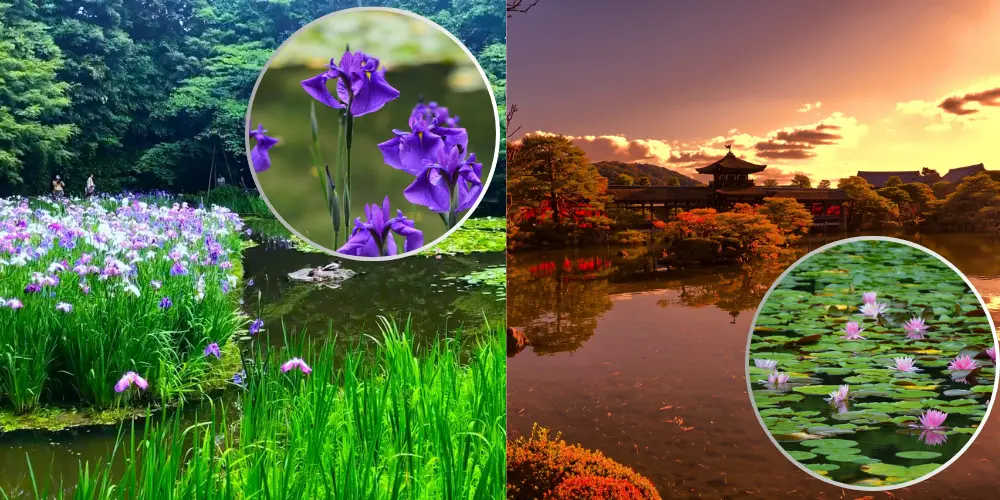
| Visiting Hours | March 1st – March 14th Visiting hours: 8:30 AM – 5:30 PM (Last entry at 5:00 PM) March 15th – September 30th Visiting hours: 8:30 AM – 6:00 PM (Last entry at 5:30 PM) October 1st – October 31st Visiting hours: 8:30 AM – 5:30 PM (Last entry at 5:00 PM) October 22nd (Jidai Matsuri Festival) Visiting hours: 9:30 AM – 11:30 AM (Closed at 12:00 PM) November 1st – End of February Visiting hours: 8:30 AM – 5:00 PM (Last entry at 4:30 PM) |
| Initial Offering Fee | adult 600 Yen, Kids 300 Yen |
| Details | https://www.heianjingu.or.jp/shrine/garden.html |
After visiting the Daigokuden, make sure to explore the Shin’en garden. Enter through the entrance near Byakko-ro Tower and pay an admission fee of 600 yen for adult.
The Shin’en garden consists of four distinct sections (East, Middle, West, and South), each offering beautiful seasonal views across a total area of approximately 33,000 square meters (about 8 acres). This expansive garden was designed by renowned Meiji-era landscape architect Jihei Ogawa VII and his team. Its unique beauty was recognized in 1975 when it was designated a Place of Scenic Beauty by the Japanese government.
The cherry blossoms in spring and the vibrant autumn foliage are particularly breathtaking. Take your time to stroll through the garden and immerse yourself in the elegant atmosphere of the Heian period.
Access to Heian Shrine
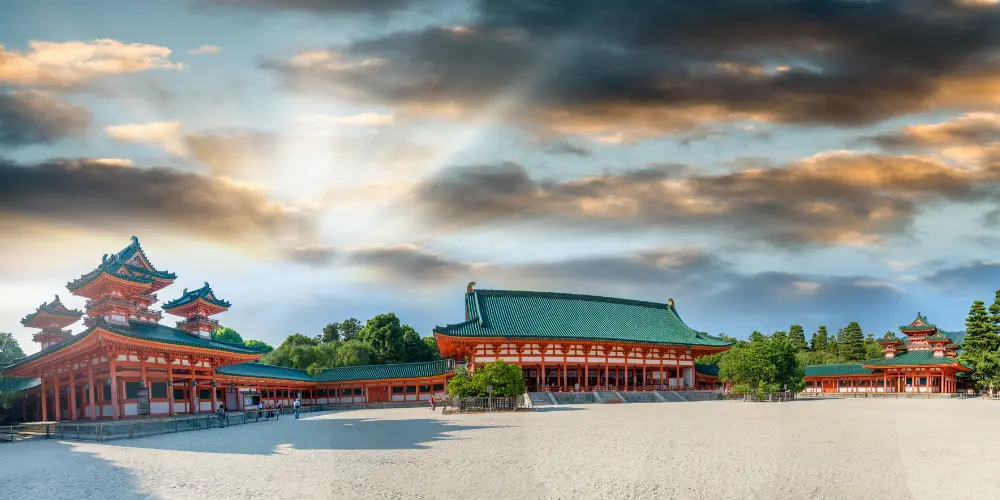
To reach Heian Shrine from Kyoto Station
Take the city bus No. 5 or the Raku Bus No. 100 or 110. The journey takes about 30 minutes. Get off at the “Okazaki Koen/Bijutsukan, Heian Jingu-mae” bus stop and walk north for 5 minutes to reach the shrine.
From Hankyu Kyoto Kawaramachi Station
Take the city bus No. 5, 46, or 32. The ride takes about 20 minutes. Get off at either the “Okazaki Koen/Bijutsukan, Heian Jingu-mae” bus stop or the “Okazaki Koen/Rohm Theatre Kyoto, Miyakomesse-mae” bus stop and walk north for 5 minutes to reach the shrine.
Buses to Heian Shrine
It can often be crowded. To avoid the crowds, it is recommended to use the subway or Keihan Railway. From Higashiyama Station on the Subway Tozai Line, take Exit 1 and walk for 10 minutes. From Sanjo Station or Jingu-Marutamachi Station on the Keihan Oto Line, it is a 15-minute walk to Heian Shrine.


